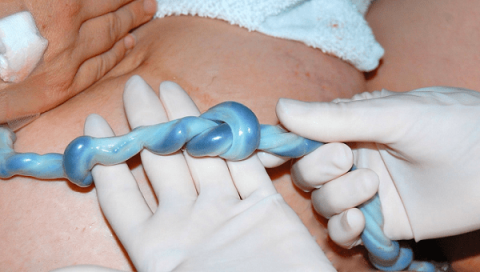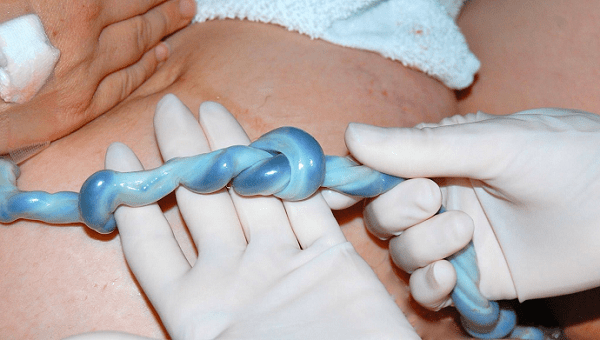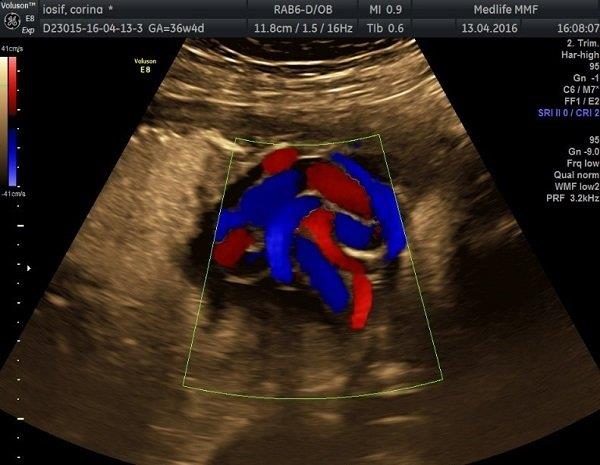What should a mother do when the baby has a knotted umbilical cord during pregnancy?

If you have ever heard of knotted umbilical cord and its consequences. Mother will probably worry and find out a lot of related information. So what is a knotted umbilical cord? How is this condition diagnosed? How to monitor good pregnancy health? Please refer to this article!
content
- 1. What is knotted umbilical cord?
- 2. How is the knotted umbilical cord formed?
- 3. Expression
- 4. How is knotted umbilical cord detected?
- 5. Should you be worried about early knotting of the umbilical cord?
- 6. What can I do for you?
- 7. How to screen early?
1. What is knotted umbilical cord?
The umbilical cord is like a long tube containing blood vessels connecting the mother and the baby through the placenta. The main function of the umbilical cord is to carry oxygen and nutrients to the baby.
To understand more about the function and other related problems of the umbilical cord, please refer to: Umbilical cord – Overview and common problems
There are actually two types of knots that can form in a baby's umbilical cord. It's real and fake knotted umbilical cord.
1.1 Pseudo-knotted umbilical cord (Pseudoknots):
This is a condition where, on an ultrasound, any bulge or protrusion on the baby's umbilical cord will show a false knot. Anatomical “knots” are small variations of the umbilical cord. This condition is caused by bulging blood vessels or by thickening of Wharton's jelly anywhere in the umbilical cord.
In fact, these false knots are relatively common during pregnancy. Fortunately, false knots have no medical significance and pose no danger to your baby.
1.2 True knotted umbilical cord:
As its name suggests, a real knot forms when the umbilical cords entwine and form a knot similar to how we tie a rope.

Image of the umbilical cord knotted after birth
In this article only the actual knotted umbilical cord is mentioned.
A knotted umbilical cord can form during pregnancy (when the baby is active and moving in the amniotic fluid) and during birth.
This condition occurs in less than 2% of pregnancies. Most knots are relatively loose and do not affect the baby.
However, in cases where the umbilical cord knots early, the baby's growth and movement towards the end of pregnancy can make the knot even tighter. The consequences can be to cut off the supply of oxygen and nutrients to the baby. The knot will become even more dangerous when the baby is about to be born. In extreme cases, it can lead to the baby suffocating at birth due to lack of oxygen, brain damage or even death. Statistics show that tight knots have a perinatal mortality rate of 10%.
2. How is the knotted umbilical cord formed?
Early in pregnancy, your baby has plenty of room to move around in the womb. When moving around the umbilical cord, your baby may accidentally tighten and pull the umbilical cord into a knot. Some sources suggest that most knots are formed between 9-12 weeks of pregnancy. In some cases, a knot can still form during labor.
In addition, risk factors that can increase cord knots include:
- Elderly mother
- Thai is a boy
- Abnormally long umbilical cord
- Too much amniotic fluid in the amniotic cavity (polyhydramnios)
- Pregnant from the 2nd time onwards
- Multiple pregnancy (twins, triplets, ..)
During labor, knots are formed or tightened as the baby needs to move through the birth canal to be born. In fact, to prevent possible adverse effects on the baby during labor, there is always a monitor to monitor the baby's fetal heart rate. When there are any signs of fetal distress, it may be due to umbilical cord knotting or other causes. Your doctor may recommend an emergency cesarean section to ensure your baby's safety.
3. Expression
Decreased fetal activity after 37 weeks of gestation is the most common sign. You may feel your baby's movements are weaker or weaker than usual. This condition is also shown by an abnormally reduced fetal heart rate. This happens when the knot is tightened too tightly, preventing the baby from getting enough oxygen.
4. How is knotted umbilical cord detected?
Prenatal ultrasound is the method of choice for diagnosis. When there are several risk factors, such as: polyhydramnios, long umbilical cord, multiple pregnancy, the umbilical cord examination is done more often. Specifically, 4D ultrasound, color doppler ultrasound are the most important tests for prenatal assessment and diagnosis.

As for the mother, there is nothing she can do to prevent the formation of a knot. However, the mother can completely monitor the fetal movements through the regular fetal machine. This monitoring is absolutely helpful to detect if there is any abnormality with the baby or not.
Furthermore, if a knot is formed early in pregnancy, signs of fetal distress may appear around 37 weeks. Therefore, mothers need to be more concerned about the fetus in the weeks leading up to delivery.
If a knot is formed during delivery, the fetal heart monitor will show an irregular heartbeat.
5. Should you be worried about early knotting of the umbilical cord?
Fortunately, the blood vessels in the umbilical cord are covered by a cushion called Wharton's jelly. This padding will protect the umbilical cord blood vessels.
So the knot will not affect the baby as long as the knot is still loose.
If the knot is too tight, it can block the flow of blood from the placenta to the baby and cause lack of oxygen. Such a complication often occurs during labor, when the baby passes through the birth canal. However, this situation is very rare.
6. What can I do for you?
In fact, there is nothing we can do to prevent or prevent it. However, the mother can monitor the overall health of the baby, especially the last stage of pregnancy, by checking the fetus regularly. If the mother finds that there is an abnormality in the fetus, such as the fetus, the fetus is weaker, less. Go to the Obstetrics and Gynecology facility for a checkup and wait until the next day.

Monitoring fetal movements helps mothers know the health status of the fetus regularly
In cases where the loose knot tightens during delivery, the doctor can detect it by a decrease in the fetal heart rate. At this point, the doctor will make appropriate decisions to keep your baby safe when born. Usually the best way is to have a cesarean section.
7. How to screen early?
When there are risk factors, you need to have multiple ultrasound scans to check the umbilical cord. The knotted umbilical cord usually does not cause much harm to the baby. However, in some cases, the condition can lead to an intrauterine stillbirth.
For this reason, when risk factors are present, more frequent ultrasounds are needed. Once diagnosed with a knotted umbilical cord, close monitoring of the fetal condition throughout pregnancy and delivery is essential. Usually, your doctor may recommend that you be admitted to the hospital for close and ongoing monitoring. Knots can tighten at any time, especially during labor.
>> See more: How does the umbilical cord wrap the neck affect the baby, is it worrisome?
Knotted umbilical cord is one of the concerns of pregnant women. Knowing more about her problem helps mothers feel secure and know how to closely monitor the fetus. In addition, regular check-ups are extremely important to help doctors and mothers detect abnormalities, if any, and help manage pregnancy closely to give birth to healthy and intelligent babies.
Written by: Hoang Yen